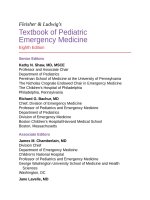Pediatric emergency medicine trisk 0317 0317
Bạn đang xem bản rút gọn của tài liệu. Xem và tải ngay bản đầy đủ của tài liệu tại đây (71.09 KB, 1 trang )
referring facility. This online “medical control” or “medical command” model
enables clinicians to direct care after assessments are transmitted to them.
Typically, after the transport team makes contact with the patient and completes
an assessment, the team contacts the medical command physician to review the
management plan and prepare for the transport back to the accepting institution.
At that time, additional clinical information may be reviewed between the team
and the medical command physician. Additionally, electronically transmitted
data, such as ECGs, and transferred images, including plain radiographs and CTs
may be reviewed and discussed real time. Online medical command may be
particularly important in tertiary and quaternary care patient populations, where
patients may require unique interventions (e.g., patients with complex congenital
heart disease, or metabolic disorders). Potential drawbacks include additional
reporting time spent at the referring institution (can be mitigated by on
communications en route), time demands on the receiving medical staff directing
care, potential decision-making inconsistency within variable medical control
staff, and technical problems with the communications equipment. Accomplished
efficiently and appropriately, however, direct online communications (in
conjunction with off-line training, guidelines, and protocols) can help support the
primary goals of interfacility transport, including stabilization, improvement, and
seamless transition to next stage of care via improved awareness (by the most
experienced clinicians) of current state, response (or not) to interventions, and
preparation of needs at next stage/location of care.
Indirect Medical Control
Indirect medical control includes the medical management of a transport system
through the use of established care guidelines in place before the call for help
arrives. The medical director for a service, who is ultimately responsible for every
aspect of patient care, authorizes the personnel to utilize standard protocols for
the care of patients in order to save time and reduce the variability of orders. This
has the benefit of saving time in critical situations, as well as reducing
interoperator variability in patient assessment and medical decision making. In
most systems, the option remains for personnel to speak with a clinician for direct
medical control, if they have questions, or if the protocol does not clearly apply.
This may also be necessary for certain procedures or medications considered to
be higher risk to the patient. In EMS, the protocols may be established by the
regional or state EMS authority, while in interfacility transport, these are
determined by the transporting service, often in conjunction with physician
content experts. Medical control physicians should be literate with transport
guidelines, protocols, personnel capabilities, medications, and equipment to be









